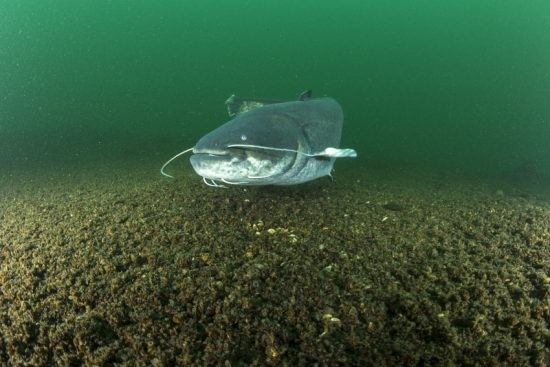Wels catfish
(Silurus soldatovi)

Description
The wels catfish, also called sheatfish or just wels, is a large species of catfish native to wide areas of central, southern, and eastern Europe, in the basins of the Baltic, Black and Caspian Seas. It has been introduced to Western Europe as a prized sport fish and is now found from the United Kingdom east Kazakhstan and China and south to Greece and Turkey. It is a freshwater fish recognizable by its broad, flat head and wide mouth. Wels catfish can live for at least fifty years. The wels catfish's mouth contains lines of numerous small teeth, two long barbels on the upper jaw and four shorter barbels on the lower jaw. It has a long anal fin that extends to the caudal fin, and a small sharp dorsal fin relatively far forward. The wels relies largely on hearing and smell for hunting prey (owing to its sensitive Weberian apparatus and chemoreceptors respectively), although like many other catfish, the species is characterised with a tapetum lucidum, providing its eyes with a degree of sensitivity at night, when the species is most active. With its sharp pectoral fins, it creates an eddy to disorient its victim, which the predator sucks into its mouth and swallows whole. The skin is very slimy. Skin colour varies with environment. Clear water will give the fish a black color, while muddy water will often tend to produce green-brown specimens. The underside is always pale yellow to white in colour. Albinistic specimens are known to exist and are caught occasionally. Wels swim in a fashion similar to eels, and so can swim backwards. There are concerns about the ecological impact of introducing the wels catfish to regions where it is not native. Following the introduction of wels catfish, populations of other fish species have undergone steep declines. Since its introduction in the Mequinenza Reservoir in 1974, it has spread to other parts of the Ebro basin, including its tributaries, especially the Segre River. Some endemic species of Iberian barbels, genus Barbus in the Cyprinidae that were once abundant, especially in the Ebro river, have disappeared due to competition with and predation by wels catfish. The ecology of the river has also changed, with a major growth in aquatic vegetation such as algae.
Taxonomic tree:







